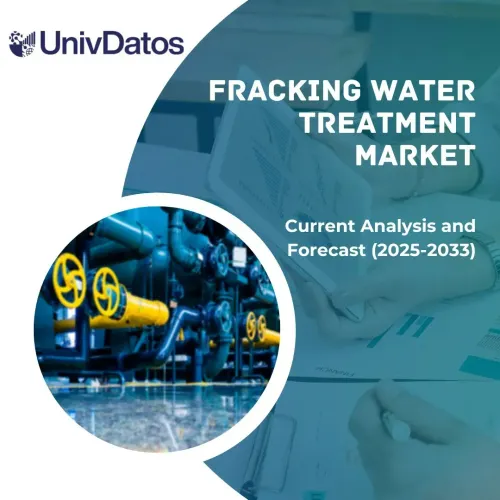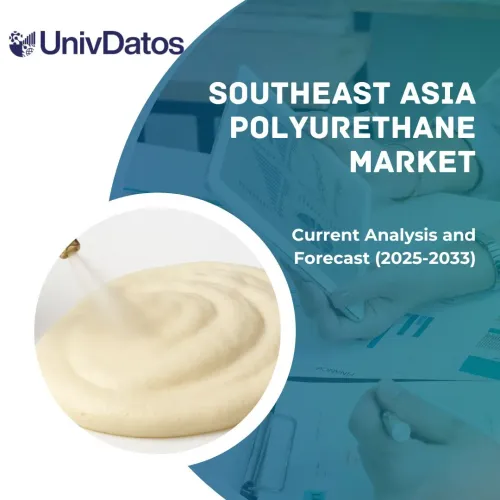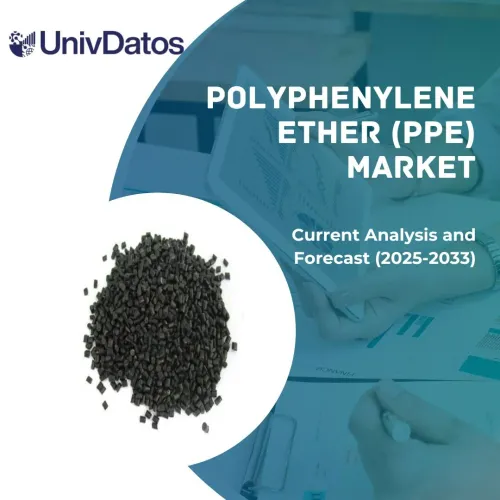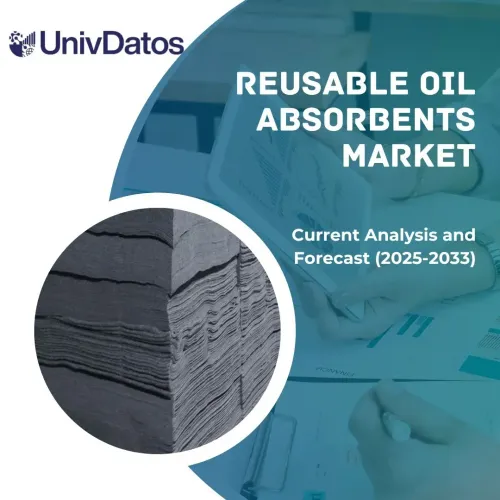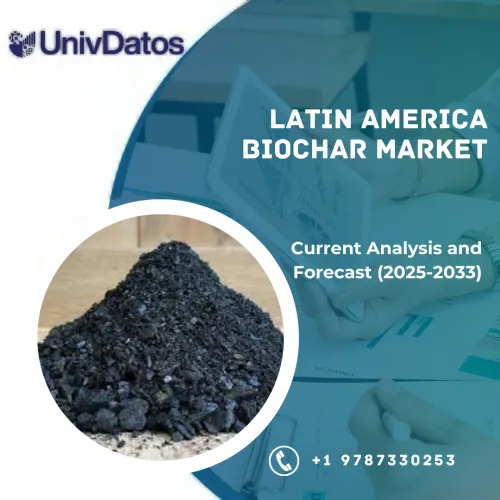- Startseite
- Über uns
- Industrie
- Dienstleistungen
- Lesen
- Kontaktieren Sie uns
Markt für Flotationsreagenzien: Aktuelle Analyse und Prognose (2021-2027)
Schwerpunkt auf Typ (Flockungsmittel, Kollektoren, Schäumer, Dispergiermittel und Sonstige); Anwendung (Wasser- und Abwasserbehandlung, Sprengstoffe und Bohren, Papierrecycling, Industrielle Verarbeitung und Sonstige) und Region/Land
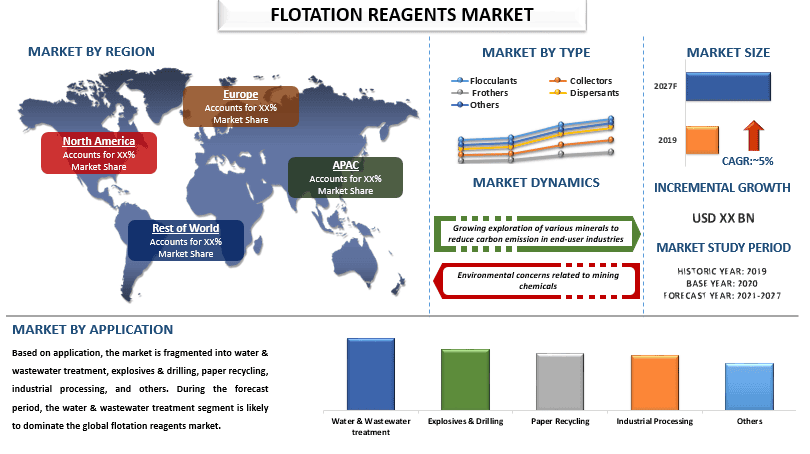
Es wird erwartet, dass der globale Flotationsreagenz-Markt im Prognosezeitraum (2021–2027) eine CAGR von rund 5,27 % verzeichnen wird. Da der Markt voraussichtlich aufgrund der rasanten Urbanisierung, des Anstiegs des verfügbaren Einkommens und der Industrialisierung weltweit einen Aufschwung erleben wird. Laut der Europäischen Kommission und dem EU-Forschungs- und Innovationsmagazin wird die Nachfrage nach Elektrofahrzeugen und Energiespeichern bis zum Jahr 2050 um 500 % steigen, was sich positiv auf das Marktwachstum von Mineralien wie Graphit, Lithium und Kobalt im prognostizierten Zeitraum auswirken wird.
Flotationsreagenzien beziehen sich auf das Mittel, das im Mineralflotationsprozess verwendet wird, der das Flotationsverhalten von Mineralien anpassen kann, wodurch eine gute Mineraltrennung erreicht wird. Darüber hinaus ist die Verwendung von Flotationsreagenzien die flexibelste, effektivste und bequemste Methode zur Steuerung des Flotationsprozesses. Da dieser Prozess die Belüftung von Mineralien in Wasser in Gegenwart von Flotationsreagenzien beinhaltet. Flotationsreagenzien umfassen pH-Wert-Promotoren, Regulatoren, Konditionierungsmittel, Schleimdispergiermittel, Sulfidierungsmittel, Aktivatoren und andere. Sie sind in verschiedenen Formen erhältlich, z. B. in fester, Pellet- und flüssiger Form. Einige Flotationsreagenzien sind in verschiedenen Typen erhältlich, die nichtionisch, kationisch oder anionisch sind.
BASF SE, Cytec Solvay Group, Orica, Dow Chemical, Kao Corporation, Clariant AG, Evonik, Huntsman Corporation, Kemira Oyj und AkzoNobel. Mehrere M&As sowie Partnerschaften wurden von diesen Akteuren unternommen, um den Flotationsreagenz-Markt zu entwickeln.
Covid-19 hat jedoch die Weltwirtschaft verwüstet, wodurch viele Sektoren einen Rückgang erlebten. Mehrere Länder erließen landesweite Lockdowns als Teil von Maßnahmen zur Begrenzung der Ausbreitung des Coronavirus. Das Wachstum des Flotationsreagenz-Marktes war auch von der Schließung von Produktionsaktivitäten und dem Rückgang der Nachfrage nach kommerziellen Dienstleistungen im Jahr 2020 betroffen. Darüber hinaus verschärfte die Volatilität der Reagenzpreise während der Pandemie die Auswirkungen auf den Markt für Flotationsreagenzien zusätzlich. Da sich COVID in Richtung sauberer Energie und Netto-Null-Emissionen verlagert hat, was voraussichtlich die Nachfrage nach erneuerbaren Energien in den nächsten Jahren ankurbeln und die Abhängigkeit von Öl, Gas und Kohle minimieren wird, wird dies den Markt für die Verwendung von Flotationsreagenzien im prognostizierten Zeitraum antreiben.
Im Bericht dargestellte Erkenntnisse
"Unter den Typen halten Schäumer einen bedeutenden Anteil am Markt"
Basierend auf dem Typ ist der Markt in Flockungsmittel, Sammler, Schäumer, Dispergiermittel und andere unterteilt. Während des Prognosezeitraums wird das Schäumersegment voraussichtlich den globalen Flotationsreagenz-Markt dominieren. Der Einsatz von Schäumern nimmt zu, da er als Flotationsreagenz in verschiedenen partikulären Stoffen vielfältige Aufgaben erfüllt. Darüber hinaus ist die Schaumflotation ein Verfahren zur selektiven Trennung hydrophober Materialien von hydrophilen Materialien. Dies wird in der Mineralverarbeitung, im Papierrecycling und in der Abwasserbehandlung eingesetzt. Faktoren wie das steigende Bewusstsein von Herstellern und Verbrauchern, Papier zu recyceln, um Nachhaltigkeit zu erreichen, erhöhen die Marktgröße des Flotationsreagenz-Marktes. Zum Beispiel: Laut der Environmental Protection Agency (EPA) wurden 2018 etwa 46 Millionen Tonnen Papier und Pappe recycelt, was einer Recyclingquote von 68,2 Prozent entspricht, was im Vergleich zu anderen Materialien im Siedlungsabfall (MSW) am höchsten war.
"Unter den Anwendungen wird die Wasser- und Abwasserbehandlung einen bedeutenden Anteil am Markt halten"
Basierend auf der Anwendung ist der Markt in Wasser- und Abwasserbehandlung, Sprengstoffe & Bohrungen, Papierrecycling, industrielle Verarbeitung und andere unterteilt. Während des Prognosezeitraums wird das Segment Wasser- und Abwasserbehandlung voraussichtlich den globalen Flotationsreagenz-Markt dominieren. Darüber hinaus entsorgen viele Industrien verschiedene kontaminierte chemische Wasser, die schädliche synthetische Verbindungen enthalten, von denen erwartet wird, dass sie die Abfall- und Abwasserbehandlung einsetzen, was sich positiv auf das Wachstum des Flotationsreagenz-Marktes auswirken wird.
Asien-Pazifik wird im Prognosezeitraum ein deutliches Wachstum verzeichnen"
Asien-Pazifik ist aufgrund seines schnellen Bevölkerungswachstums, das zu der Nachfrage nach sauberem Trinkwasser in der Region führt, eine der am schnellsten wachsenden Regionen für Flotationsreagenzien. Darüber hinaus wächst Indiens Wasserbedarf rasant, und die Regierung ergreift auch verschiedene Maßnahmen und setzt Strategien für sauberes Wasser um. Dies wird daher die Abwassermenge im Land erhöhen, was sich positiv auf das Wachstum des Flotationsreagenz-Marktes auswirken wird. Darüber hinaus verhängt die Regierung bestimmte Regeln & Vorschriften für die Abwasserbehandlung, die durch viele Mineralressourcen wie Kohle, Zink, Kupfer und andere erhöht wird, was zum Wachstum von Flotationsreagenzien auf dem Markt in den kommenden Jahren beitragen wird. Darüber hinaus werden in Indien laut dem Composite Water Management Index – Niti Aayog aufgrund der Wasserkrise in einem Business-as-usual-Szenario bis 2050 6 % des BIP verloren gehen. Daher werden die wachsenden Bergbauaktivitäten die Nachfrage nach Flotationsreagenzien im prognostizierten Zeitraum antizipieren.
Gründe für den Kauf dieses Berichts:
- Die Studie umfasst Marktgrößen- und Prognoseanalysen, die von authentifizierten wichtigen Branchenexperten validiert wurden.
- Der Bericht bietet einen schnellen Überblick über die Gesamtleistung der Branche auf einen Blick.
- Der Bericht umfasst eine eingehende Analyse prominenter Branchenkollegen mit einem primären Fokus auf wichtige Finanzdaten, Produktportfolios, Expansionsstrategien und aktuelle Entwicklungen.
- Detaillierte Untersuchung der Treiber, Beschränkungen, wichtigsten Trends und Chancen, die in der Branche vorherrschen.
- Die Studie deckt den Markt umfassend über verschiedene Segmente hinweg ab.
- Tiefgreifende regionale Analyse der Branche.
Anpassungsoptionen:
Der globale Flotationsreagenz-Markt kann gemäß den Anforderungen oder einem anderen Marktsegment weiter angepasst werden. Darüber hinaus versteht UMI, dass Sie möglicherweise Ihre eigenen geschäftlichen Anforderungen haben. Nehmen Sie daher Kontakt mit uns auf, um einen Bericht zu erhalten, der Ihren Anforderungen vollständig entspricht.
Inhaltsverzeichnis
Forschungsmethodik für die globale Flotationsreagenz-Marktanalyse (2021-2027)
Die Analyse des historischen Marktes, die Schätzung des aktuellen Marktes und die Prognose des zukünftigen Marktes für den globalen Flotationsreagenz-Markt waren die drei wichtigsten Schritte, die unternommen wurden, um die Akzeptanz von Flotationsreagenzien in wichtigen Regionen weltweit zu erstellen und zu analysieren. Umfassende Sekundärforschung wurde durchgeführt, um die historischen Marktzahlen zu erfassen und die aktuelle Marktgröße zu schätzen. Zweitens wurden zahlreiche Erkenntnisse und Annahmen berücksichtigt, um diese Erkenntnisse zu validieren. Darüber hinaus wurden umfassende Primärinterviews mit Branchenexperten entlang der Wertschöpfungskette des globalen Flotationsreagenz-Marktes geführt. Nach der Annahme und Validierung der Marktzahlen durch Primärinterviews wendeten wir einen Top-Down/Bottom-Up-Ansatz an, um die vollständige Marktgröße zu prognostizieren. Danach wurden Methoden zur Aufschlüsselung des Marktes und zur Datentriangulation angewandt, um die Marktgröße von Segmenten und Untersegmenten der betreffenden Branche zu schätzen und zu analysieren. Die detaillierte Methodik wird im Folgenden erläutert:
Analyse der historischen Marktgröße
Schritt 1: Eingehende Untersuchung von Sekundärquellen:
Es wurde eine detaillierte Sekundärstudie durchgeführt, um die historische Marktgröße des Flotationsreagenz-Marktes über unternehmensinterne Quellen wie Jahresberichte & Finanzberichte, Performance-Präsentationen, Pressemitteilungen usw. und externe Quellen wie Fachzeitschriften, Nachrichten & Artikel, Veröffentlichungen von Regierungsbehörden, Veröffentlichungen von Wettbewerbern, Sektorberichte, Datenbanken von Drittanbietern und andere glaubwürdige Veröffentlichungen zu erhalten.
Schritt 2: Marktsegmentierung:
Nachdem wir die historische Marktgröße des Flotationsreagenz-Marktes erhalten hatten, führten wir eine detaillierte Sekundäranalyse durch, um historische Markteinblicke zu gewinnen und Anteile für verschiedene Segmente & Untersegmente für wichtige Regionen zu ermitteln. Die wichtigsten im Bericht enthaltenen Segmente sind Art und Anwendung. Darüber hinaus wurden Länderanalysen durchgeführt, um die allgemeine Akzeptanz von Testmodellen in der jeweiligen Region zu bewerten.
Schritt 3: Faktorenanalyse:
Nachdem wir die historische Marktgröße verschiedener Segmente und Untersegmente erfasst hatten, führten wir eine detaillierte Faktorenanalyse durch, um die aktuelle Marktgröße des Flotationsreagenz-Marktes zu schätzen. Darüber hinaus führten wir eine Faktorenanalyse unter Verwendung abhängiger und unabhängiger Variablen durch, wie z. B. die steigende Nachfrage nach Flotationsreagenzien in der Abwasserindustrie. Es wurde eine gründliche Analyse für Angebots- und Nachfrageszenarien unter Berücksichtigung von Top-Partnerschaften, Fusionen und Übernahmen, Geschäftsausweitungen und Produkteinführungen im Bereich des Flotationsreagenz-Marktes weltweit durchgeführt.
Schätzung & Prognose der aktuellen Marktgröße
Aktuelle Marktgrößenbestimmung: Basierend auf den umsetzbaren Erkenntnissen aus den oben genannten 3 Schritten ermittelten wir die aktuelle Marktgröße, die wichtigsten Akteure auf dem globalen Flotationsreagenz-Markt und die Marktanteile der Segmente. Alle erforderlichen prozentualen Anteile und Marktaufschlüsselungen wurden unter Verwendung des oben genannten Sekundäransatzes ermittelt und durch Primärinterviews verifiziert.
Schätzung & Prognose: Für die Marktschätzung und -prognose wurden verschiedenen Faktoren, einschließlich Triebkräften & Trends, Beschränkungen und Chancen, die den Stakeholdern zur Verfügung stehen, Gewichtungen zugewiesen. Nach der Analyse dieser Faktoren wurden relevante Prognosetechniken, d. h. der Top-Down/Bottom-Up-Ansatz, angewendet, um die Marktprognose für 2027 für verschiedene Segmente und Untersegmente in den wichtigsten Märkten weltweit zu erstellen. Die zur Schätzung der Marktgröße angewandte Forschungsmethodik umfasst:
- Die Marktgröße der Branche in Bezug auf den Umsatz (USD) und die Akzeptanzrate des Flotationsreagenz-Marktes in den wichtigsten Märkten im Inland
- Alle prozentualen Anteile, Aufteilungen und Aufschlüsselungen der Marktsegmente und Untersegmente
- Die wichtigsten Akteure auf dem globalen Flotationsreagenz-Markt in Bezug auf Art und Anwendung. Außerdem die von diesen Akteuren angewandten Wachstumsstrategien, um im schnell wachsenden Markt wettbewerbsfähig zu sein
Validierung von Marktgröße und -anteil
Primärforschung: Es wurden ausführliche Interviews mit den wichtigsten Meinungsführern (Key Opinion Leaders, KOLs) geführt, darunter Führungskräfte der obersten Ebene (CXO/VPs, Vertriebsleiter, Marketingleiter, Betriebsleiter, Regionalleiter, Länderleiter usw.) in wichtigen Regionen. Die Ergebnisse der Primärforschung wurden dann zusammengefasst und eine statistische Analyse durchgeführt, um die aufgestellte Hypothese zu beweisen. Die Ergebnisse der Primärforschung wurden mit den Sekundärergebnissen zusammengeführt, wodurch Informationen in umsetzbare Erkenntnisse umgewandelt wurden.
Aufteilung der Primärteilnehmer in verschiedene Regionen
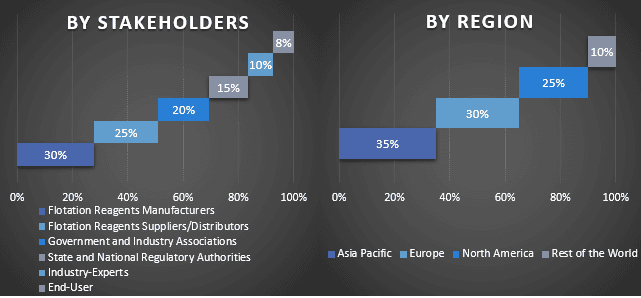
Market Engineering
Die Datentriangulationstechnik wurde eingesetzt, um die Gesamtmarktschätzung abzuschließen und eine präzise statistische Zahl für jedes Segment und Untersegment des globalen Flotationsreagenz-Marktes zu erhalten. Die Daten wurden in mehrere Segmente und Untersegmente aufgeteilt, nachdem verschiedene Parameter und Trends in den Bereichen verschiedener Arten und Anwendungen auf dem globalen Flotationsreagenz-Markt untersucht wurden.
Das Hauptziel der globalen Flotationsreagenz-Marktstudie
Die aktuellen und zukünftigen Markttrends, die über den globalen Flotationsreagenz-Markt hinausgehen, wurden in der Studie genau bestimmt. Investoren können strategische Einblicke gewinnen, um ihre Entscheidung für Investitionen auf der Grundlage der in der Studie durchgeführten qualitativen und quantitativen Analyse zu treffen. Aktuelle und zukünftige Markttrends bestimmten die Gesamtattraktivität des Marktes auf regionaler Ebene und boten den Industrieteilnehmern eine Plattform, um den unerschlossenen Markt zu nutzen und von einem First-Mover-Vorteil zu profitieren. Weitere quantitative Ziele der Studien sind:
- Analyse der aktuellen und prognostizierten Marktgröße des Flotationsreagenz-Marktes in Bezug auf den Wert (USD). Außerdem Analyse der aktuellen und prognostizierten Marktgröße verschiedener Segmente und Untersegmente.
- Zu den Segmenten in der Studie gehören die Bereiche Art und Anwendung.
- Definition und Analyse des regulatorischen Rahmens für die Flotationsreagenz-Marktindustrie.
- Analyse der Wertschöpfungskette unter Einbeziehung verschiedener Vermittler sowie Analyse des Kunden- und Wettbewerberverhaltens der Branche.
- Analyse der aktuellen und prognostizierten Marktgröße des Flotationsreagenz-Marktes für die wichtigste Region.
- Zu den wichtigsten Ländern der in dem Bericht untersuchten Regionen gehören der asiatisch-pazifische Raum, Europa, Nordamerika und der Rest der Welt.
- Unternehmensprofile des Flotationsreagenz-Marktes und die von den Marktteilnehmern angewandten Wachstumsstrategien, um sich in dem schnell wachsenden Markt zu behaupten
- Tiefgehende Analyse der Branche auf regionaler Ebene
Verwandt Berichte
Kunden, die diesen Artikel gekauft haben, kauften auch




